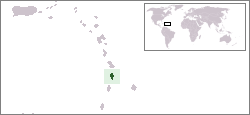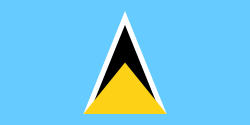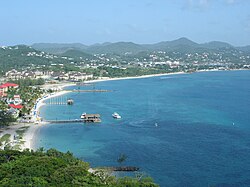Saint Lucia
Saint Lucia is a tropical island country in the eastern Caribbean Sea. It is a part of the Lesser Antilles island group, and it is north of the islands of Saint Vincent and the Grenadines and south of Martinique. As of 2010 there are about 174,000 people.
Saint Lucia | |
|---|---|
| Motto: | |
| Anthem: | |
 | |
| Capital and largest city | Castries |
| Official languages | English[1][2] |
| Saint Lucian French Creole[1][2] | |
| Ethnic groups |
|
| Demonym(s) | Saint Lucian |
| Government | Parliamentary democracy under constitutional monarchy |
• Monarch | Charles III |
| Cyril Errol Charles | |
| Philip J. Pierre | |
| Legislature | Parliament |
| Senate | |
| House of Assembly | |
| Independence | |
• from the United Kingdom | 22 February 1979 |
| Area | |
• Total | 617 km2 (238 sq mi) (191st) |
• Water (%) | 1.6 |
| Population | |
• 2021 estimate | |
• 2010 census | 165,595 |
• Density | 299.4/km2 (775.4/sq mi) (29th) |
| GDP (PPP) | 2020 estimate |
• Total | |
• Per capita | |
| GDP (nominal) | 2020 estimate |
• Total | |
• Per capita | |
| Gini (2016) | 51.2[4] high |
| HDI (2019) | high · 86th |
| Currency | East Caribbean dollar (XCD) |
| Time zone | UTC−4 |
| Driving side | left |
| Calling code | +1 758 |
| ISO 3166 code | LC |
| Internet TLD | .lc |
The official language is English.[1][2] Saint Lucian Creole French (Kwéyòl), which is a French-based Creole is spoken by 95% of the people. About 70% of the people are Roman Catholic.
Two Nobel laureates, Arthur Lewis, an economist, and Derek Walcott, a poet and playwright, have come from the island.
Saint Lucia is a full and participating member of the Caribbean Community (CARICOM), Organisation of Eastern Caribbean States (OECS) and La Francophonie.
Saint Lucia is the only country in the world to be named after a woman, Saint Lucy.
History
The first proven inhabitants of the island, the Arawaks, are believed to have first settled in AD 200–400. Around 800 AD, the island would be taken over by the Kalinago.
The French were the first Europeans to settle on the island, and they signed a treaty with the native Caribs in 1660. England took control of the island in 1663. In ensuing years, England and France fought 14 times for control of the island, and the rule of the island changed frequently. Eventually, the British took full control in 1814.
In 1979, Saint Lucia peacefully gained independence from the United Kingdom but kept Elizabeth II as Head of State.
Geography

The volcanic island of Saint Lucia is more mountainous than many other Caribbean islands. The highest point is Mount Gimie, at 950 metres (3,120 ft) above sea level. Two other mountains, the Pitons, form the island's most famous landmark. They are between Soufrière and Choiseul on the western side of the island. Saint Lucia is also one of the few islands in the world that has a drive-in volcano. It is also famous for clear seas and sandy beaches.
The capital city of Saint Lucia is Castries. Over one third of all the people live in the capital. Major towns include Gros Islet, Soufrière and Vieux Fort.
The local climate is tropical. They have northeast trade winds. There is a dry season from December 1 to May 31, and a wet season from June 1 to November 30.
Quarters
Saint Lucia has 11 quarters, or parishes of the island.
Cities
The cities in Saint Lucia are:
Politics
Saint Lucia is a constitutional monarchy, which means that the monarch (King Charles III) has no power in how the country is ruled. The King is represented by a viceroy. The Parliament is split into two "houses". The House of Assembly had 17 members who are elected by the people. The leader of the party with the most seats becomes the Prime Minister, who leads the government.
Economy
Tourism is important to Saint Lucia's economy. There are more tourists during the dry season (January to April). Saint Lucia tends to be popular due to its tropical weather and scenery and its many beaches and resorts.
Other tourist attractions include a drive-in volcano, Sulphur Springs, the Botanical Gardens, the Majestic twin Peaks "The Pitons", a world heritage site, the rain forests, and Pigeon Island National Park.
Most tourists visit Saint Lucia as part of a cruise. Most of their time tends to be spent in Castries, although Soufriere, Marigot Bay and Gros Islet are popular locations to visit.
Sport
The Windward Islands cricket team includes players from Saint Lucia. They play in the West Indies regional tournament. Darren Sammy is the first Saint Lucian to represent the West Indies. He is the current captain.[6]
Saint Lucia Media
The national anthem of Saint Lucia performed by the USN Band.
Instrumental recording of "God Save the King" the national anthem of the United Kingdom; the same tune is also used for "Oben am jungen Rhein", the national anthem of Liechtenstein.
Flag of Saint Lucia 1939–1967
Geological map of Saint Lucia.
Gros Islet and Rodney Bay, as seen from Pigeon Island
The Daren Sammy Cricket Ground in Beausejour.
Related pages
References
| Wikimedia Commons has media related to Lua error in Module:Commons_link at line 62: attempt to index field 'wikibase' (a nil value).. |
- ↑ 1.0 1.1 1.2 "About St. Lucia". Castries, St. Lucia: St. Lucis Tourist Board. Archived from the original on 2013-06-05. Retrieved 2011-11-11.
The official language spoken in Saint Lucia is English although many Saint Lucians also speak a French dialect, Creole (Kwéyòl).
- ↑ 2.0 2.1 2.2 Bureau of Western Hemisphere Affairs (U.S. Department of State) (August 12, 2011). "Background Note: Saint Lucia". United States Department of State. Retrieved 2011-11-11.
Languages: English (official); a French patois is common throughout the country.
- ↑ 3.0 3.1 3.2 3.3 "St. Lucia". International Monetary Fund. 2016.
- ↑ "Gini Index coefficient". CIA World Factbook. Retrieved 3 August 2021.
- ↑ Human Development Report 2020 The Next Frontier: Human Development and the Anthropocene (PDF). United Nations Development Programme. 15 December 2020. pp. 343–346. ISBN 978-92-1-126442-5. Retrieved 16 December 2020.
- ↑ "Charles eager to learn from Dessie Haynes". Windies cricket. Archived from the original on 8 February 2013. Retrieved 29 July 2012.








